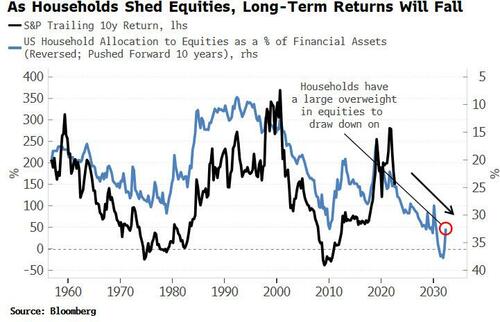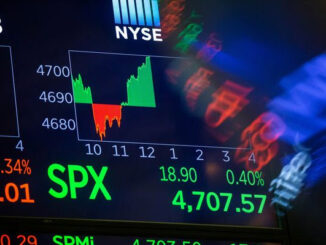
By Simon White, Bloomberg markets reporter and analyst
Equities owned by upper-middle-income households in the US are at increasing risk of liquidation as this group feels the cost-of-living crisis ever more acutely.
The pandemic saw many new precedents set. Never before had we seen economies switched off at the mains, nor such government largesse to deal with the fallout
But the aftereffects are not being spread equally. It is those in the upper-middle income groups (annual household income of about $70,000-$200,000) who:
are seeing the greatest relative rise in debt repayments
who are experiencing losses on portfolios and pensions as financial assets fall in price
have sizable mortgages compared to their net worth
are seeing the slowest wage growth
yet who often fail to qualify for much in the way of government support
This has earned them the sobriquet of the “squeezed middle,” and they have plenty of equities available to sell.
The main economic impact of the pandemic was an historic rise in savings driven by fiscal stimulus and a collapse in consumption. But after the feast, the famine, and savings are falling across all income groups. The Fed estimates that “excess savings,” the cumulative sum of savings relative to trend from the beginning of 2020, has fallen 26% in a year to $1.7 trillion.
Yet it is by drilling down we see that the economic stress is not being spread evenly, and it is those in the middle-to-upper income groups that are experiencing the most hardship relative to their recent history.
These groups are seeing excess savings built up through the pandemic eroded most quickly. Savings is disposable income net of consumption and non-mortgage interest payments. Disposable income is falling and the fall is most marked in higher income groups.
Higher-income groups are also spending less, but this is explained by the greater proportion of richer households’ expenditure being services-based, and many services that were foregone in the pandemic do not need to be replaced (you don’t need an extra haircut or yoga class for the one you missed).
Despite this, middle-income households are seeing the most stress on their savings. Bank deposits rose sharply through the pandemic, as government stimulus was (mainly) paid into household checking accounts. But recently, bank deposits have been falling.
This has been driven by a fall in savings deposits, mainly of middle-income households. Furthermore, the fall in savings deposits is greater than the rise in checking deposits, so this is more than a straight transfer of money from savings to checking accounts.
But the surest sign the middle-income groups are starting to feel the pinch is the rise in loans, with the 50%-90% income group seeing the largest rise.
Lower income groups are feeling the squeeze too, but less so relative to their own recent history. They saw a much larger rise in their income compared to their pre-pandemic trend, driven by fiscal support and, latterly, faster wage growth.
Higher-income groups are experiencing more relative economic difficulty and this is manifesting itself in savings being drawn down and more loans being taken out. But credit is tightening and loan growth is starting to slow.
One lever left to them is their investments, and therein lies risk to the equity market. The US household sector is very overweight equities versus bonds, and that is heavily concentrated in the upper-income groups: those in the 50th-to-100th income percentiles own 99.2% of the household sector’s equities; while those in the 50th-to-99th percentiles own 46%, or $15.2 trillion’s worth. That’s a lot of potential selling power.
Some liquidation may have already started. Investors’ cash allocations have risen sharply, but are still nowhere near the GFC, when equity holdings of the 50th-to-99th percentile fell almost 20% in excess of the market’s fall, implying significant selling.
Household allocation to equities in this cycle is beginning to turn lower from all-time highs. This tends to lead long-term equity returns — higher allocations typically lead to larger reductions in equity exposure, dragging down returns.
A recession is one threat equities face — a potentially even greater one is a squeezed household sector forced to sell its holdings.



